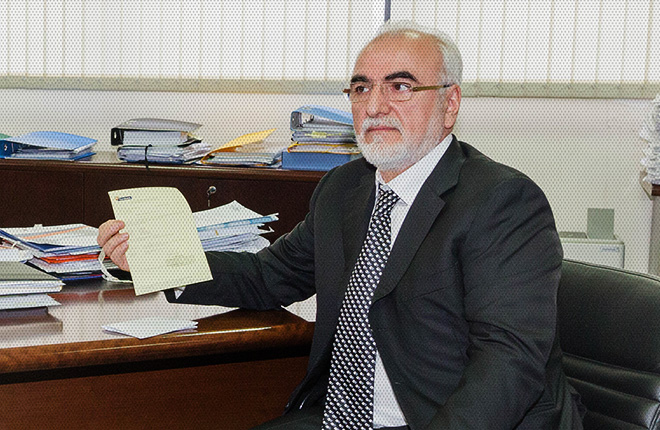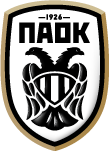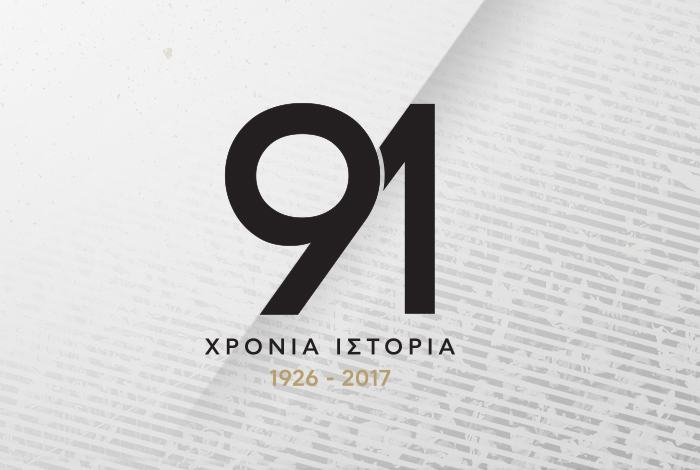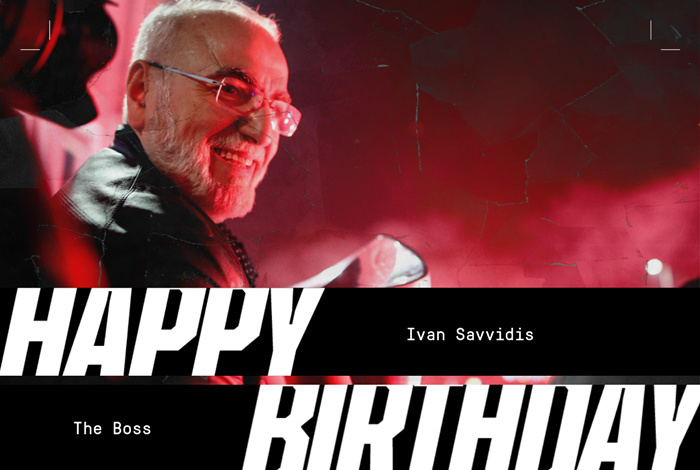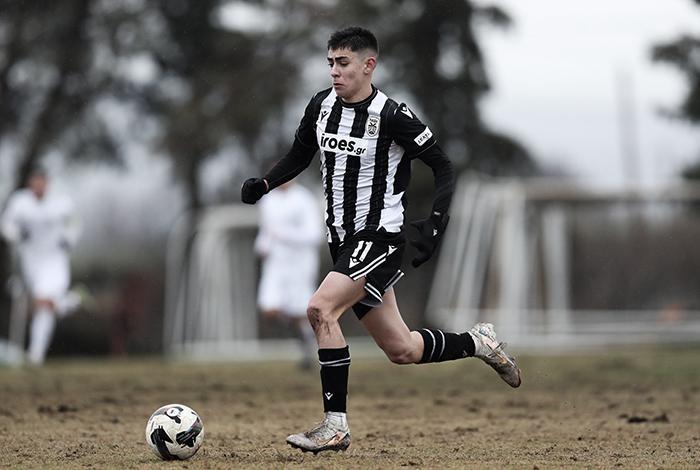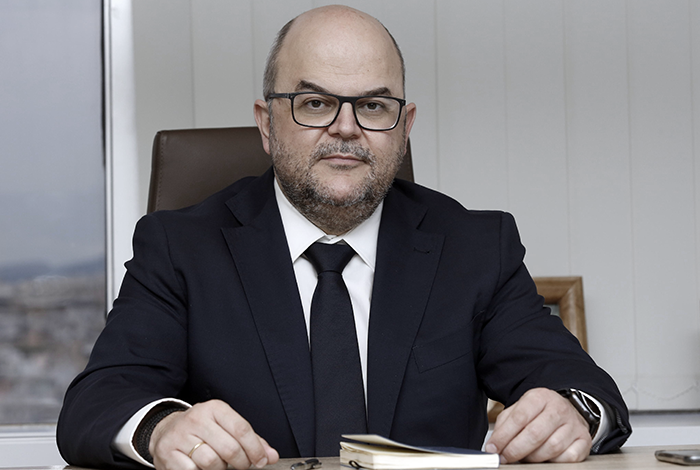Happy anniversary PAOK!
It’s been 91 years, full of passion and intensity, joys and sorrows, excitement and grief. These 91 years of life taught us to be different. To appreciate each moment. To aim for the feeling, not the result. To look our opponents in the eye, even if we end up losing. To love the club, not the titles. To be PAOK. With everything that entails…
Exactly 91 years ago today, a typical yet historic court decision would change the sports scene of Thessaloniki. The first memorandum of the Pan-Thessaloniki Athletic Club of Constantinopolitans (Panthessalonikios Athlitikos Omilos Konstantinopoliton) was approved on 20 April 1926, on an order by the Court of First Instance of Thessaloniki (No. 822).
The first emblem of PAOK (1926) depicted a four-leaf clover and a horseshoe. The leaves were green and above them were the initials of the word PAOK. The unforgettable Kostas Koemtzopoulos came up with this idea, inspired by his brand of cigarettes “Lithi”.
The first Board of Directors of PAOK consisted of:
President: Triantafyllos Triantafyllidis
First vice-president: Pantelis Kalpaktsoglou
General secretary: Konstantinos Kritikos
Special secretary: Menelaos Tsoulkas
Treasurer: Ioakim Ioakimopoulos
Director of football: Alexandros Angelopoulos
Athletes’ curator: Aristodimos Dimitriadis
Consultants: Panagiotis Maleskas, Konstantinos Koemtzopoulos and Michalis Theodosiadis.
That’s how it all started

In 1922, most refugees from Constantinople opted to set up their new homes in the centre of Thessaloniki- being bourgeois, they preferred to secure the basic comforts they enjoyed previously. They formed compact societies and went on to set up a club.
The “Union of Thessaloniki Constantinopolitans” was founded in May 1924. A year later, in June 1925 the club inaugurated their sports section. Fanourios Vyzantios was appointed president, with Nikos Petropoulosand Aristidis Misios as members of the administration. After a few months of activity in all sports, the footballers of the club along with members of the Union expressed their wish for secession from the central social club in December 1925.
The creation of AEK Thessaloniki aroused strong feelings. The procedures were cancelled, as the transfer of sporting activities should have been confirmed by the General Assembly and not the Board of Directors. Two prevailing trends appeared.
The initiative was dubbed “rebellion” via an official announcement of the “Union of Thessaloniki Constantinopolitans”. All those opposed to the division rallied around then president of the Sports Executive Committee Nikos Petropoulos. The “battle” between the two sides lasted quite a long time and the joint General Assembly took place on 7 March 1926 to settle a dispute that emerged in December 1925. Nikos Petropoulos took 92 votes, level with Aristidis Misios who was on his side, and became president.
The footballers, who had played a leading part in the secession, didn’t accept the development and sent an official announcement to the newspapers, inveighing against the new administration. “We hereby declare that we belonged and will obey the rulings of the first legal Board of Directors. We do not accept you as administration, even if you are legalized”. The new administration of AEK Thessaloniki chose to expel the players who had signed the announcement and refer them to the Union of Football Clubs of Makedonia and Thrace.
The reaction of the other part was to be expected. At first, they held an unofficial encounter against Panathinaikos on 28 March 1926 and lost 5-0.
Then, on 30 Μarch 1926, Triantafyllos Triantafyllidis,Konstantinos Koemtzopoulos, Κonstantinos Kritiko, Μichalis Theodosiadis, Ιoakim Ioakimopoulos, Αristodimos Dimitriadis, Αlexandros Angelopoulos and Μenelaos Tsoulkas gathered in the Constantinopolitans’ Club and signed the establishment protocol of the new sports club “Pan-Thessaloniki Athletic Club of Constantinopolitans”.
On 5 April, the General Assembly took place with the participation of the footballers. On 20 April 1926, PAOK’s first memorandum of association was approved on an order by the Thessaloniki Court of First Instance (No. 822).
First problems
The separation of 1926, that prompted the appearance of AEK Thessaloniki and PAOK, created a deep discord and the new club would face many problems because of it. Their members wanted to change the status quo and called all Thessaloniki clubs in an assembly on 28 July 1926 in order to propose the creation of a new Union of Football Clubs consisting only of the Thessaloniki outfits and leaving central administration to the Makedonia-Thrace Union.
PAOK were accused of mutiny because of the “false assembly” (as dubbed by EPSMTH) and were handed a three-month ban with a six-month suspension. The team’s administration wanted to prove that they were a living part of Thessaloniki’ sports scene and registered 50 players to the Union for the upcoming season, scheduled to kick off in autumn 1926.
In 1926-27, PAOK took part in the B’ Thessaloniki League, where AEK Thessaloniki were also participating. They played their first official encounter on 12 December 1926, prevailing 3-1 over Nea Genea. According to EPSMTH’s proclamation, the Union would ratify PAOK’s promotion only if they defeated all teams of A’ Thessaloniki League. They did so in style –after claiming the B’ Thessaloniki League title, they defeated all teams of the A’ League (Thermaikos, Aris and Atlantas) and gave their last match of the season at Iraklis, prevailing 1-0 over them courtesy of a Tsolakidis’s goal.
In 1927-28, PAOK took part in the A’ Thessaloniki League for the first time. In 1930-31 they qualified for their maiden participation in the Greek League. They made their debut on 1 February 1931 in Piraeus, losing 3-1 to Olympiacos.
In 1928, they engaged in yet another dispute with AEK Thessaloniki, regarding the acquisition of land to build a stadium. AEK eventually got their way, as the land was not big enough for a football field.
The merger with AEK Thessaloniki and the Syntrivani Stadium
In March 1929, the six-month effort to merge the twinned clubs finally bore fruit. AEK Thessaloniki had dissolved their football section since 1927 and preserved just the athletics’ sections. These sections were essentially absorbed, as there was no decision to merge nor were AEK Thessaloniki legally dissolved. PAOK changed their emblem, adopted the Double-Headed Eagle, took over the installations of AEK Thessaloniki (among them, the area in the Syntrivani region, where the Theological School stands today).
In 1929, both clubs tried to expand the area in order to build a home ground for PAOK. After dealing with the underground river by channeling the water through pipes, PAOK managed to lay the foundation stone on 12 December 1930, as a pre-election promise one week before municipal elections. Construction work finished relatively soon and, on 5 June 1932, the Syntrivani Stadium was inaugurated with PAOK’s 3-2 victory over Iraklis.
First success

PAOK won their first Thessaloniki League in 1937. In the following year, Nikos Sotiriadis became the first player of the Double-Headed Eagle to earn a cap with the Greece national team. On 28 May 1939 PAOK played their first Greek Cup final, losing 2-1 to AEK in Leoforos Alexandra. On their way to the final, the Thessaloniki outfit had eliminated Ellas Florina (6-1), Iraklis (3-2) and Ethnikos (4-0). In the final showdown, PAOK took the lead through Aristidis Ioannidis-Apostolou, but AEK turned the tie around with goals by Chatzistavridis and Manetas to lift the trophy. PAOK’s starting line-up that day: Sotiriadis, Koukoulas, Kontopoulos, Kalogiannis, Vatikis, Panidis, Glaros, Bostantzoglou, Arvanitidis, Ioannidis-Apostolou, Kritas.
After World War II, PAOK regrouped and in 1951 they made it once more to the Greek Cup final, held again at Leoforos Alexandra. Their rivals on that occasion were Olympiacos, who went on to win 4-0. The starting eleven of PAOK that day: Lykaris, Patakas, Golemis, Arvanitis, Gogos, Psomas, Vassiliadis, Mouratidis, Tzinopoulos, Papadakis, Emmanouilidis .
The chicos of Willy and the Golden Era

Willy Swetzik,, the Austrian coach who also played for the club back in 1931-32, made a breakthrough move in 1952 that would change PAOK’s status. He created the Academy of the Double-Headed Eagle, the renowned “chicos of Willy”, in order to trace and push forward talented players by working with them from a very young age. The experiment proved successful as the youth section produced big players who made history for PAOK, such as Leandros, Symeonidis, Giannelos, Margaritis, Giorgos Chavanidis etc.
The creation of the Academy, along with the signings of PAOK in the early ‘50s upgraded the team and marked the dawn of their first golden era. In the summer of 1953, the club signed Kouiroukidis, Petridis, Progios, Geroudis, Kemanidis, Chourvouliadis, Chasiotis and Angelidis. PAOK became an almighty force and were proclaimed Thessaloniki champions for three years in a row, boosted by the legendary trio Gentzis, Kouiroukidis, Papadakis.
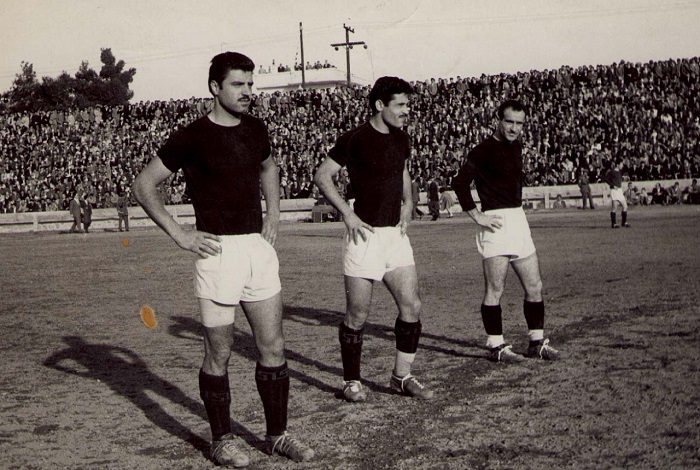
PAOK were Thessaloniki’s main representative in the Greek football stage and the senior team of the club reached their third Greek Cup final in 1955. The match was played in the home ground of their rival, Panathinaikos, in Leoforos Alexandras Stadium! Making their home advantage count, the Greens prevailed 2-0. The starting eleven of PAOK that day: Progios, Kermanidis, Geroudis, Kalogiannis, Chasiotis, Doukakis, Tsintoglou, Karafoulidis, Gentzis, Papadakis, Kiourtzis.
The construction of Toumba Stadium

The team was progressing rapidly, creating the need for the club to have their own bigger and better home ground, where they could stage their ambitions. Searching out for the best location, PAOK’s administration chose an area at Toumba that belonged to the Ministry of National Defence.
The specific area was picked for two reasons. Firstly, that neighborhood of Thessaloniki had an indissoluble bond with the refugees from Asia Minor. Secondly, the huge stretch on offer permitted PAOK to create a big arena. After the essential negotiations, the club purchased the 7.5-acre area and construction began. There was also a lottery authorized to help finance the works.

Toumba Stadium opened its gates for the first time on 6 September 1959 to welcome PAOK and their supporters. It was inaugurated by the Minister of National Defence, G. Themelis. Before kick-off of the friendly encounter against AEK, the ball was thrown from a military aircraft overflying the premises.
The inauguration of Toumba coincided with the inaugural season of the A’ Ethniki Katigoria, therefore permitting PAOK to kick off their engagements in the league in their own brand new home. The following years went by without any noteworthy success for the club. PAOK made their maiden appearance in European competition in 1965-66, when they faced Wiener SK for the Inter-Cities Fairs Cup.
The great team of the ‘70s

PAOK laid down the foundations for one of the best teams ever to grace Greek football fields. Thanks to their methodical acquisition of young talented players who went on to consolidate themselves in football’s Hall of Fame, the Double-Headed Eagle built a squad that managed to combine free-flowing attractive football with titles.
Led by Giorgos Koudas and a horde of great players like Stavros Sarafis, Achilleas Terzanidis, Dimitris Paridis, Kostas Iosifidis, Giannis Gounaris and Christos Terzanidis, PAOK became a title contender and reached milestones that still stand to this day. That team gave PAOK their first titles. From 1970 until 1974, the Double-Headed Eagle competed in five consecutive Greek Cup finals, winning the trophy twice.

The first trophy was won in 1972, when PAOK prevailed 2-1 over Panathinaikos in Karaiskakis Stadium, Koudas netting a brace in an encounter attended by 34.831 spectators. PAOK’s line-up was the following: Chatzioannou, Gounaris, Papadopoulos, Iosifidis, Fountoukidis, Terzanidis, Bellis, Sarafis (68’ Lazos), Apostolidis, Koudas, Aslanidis (76’ Mantzourakis).
Two years later, Les Shannon troops went on to defeat Olympiacos and reclaim the trophy. The score after regulation time and extra time was 2-2 and the Double-Headed Eagle won 4-3 in the penalty shootout. PAOK’s starting line-up was: Stefas, Gounaris, Tsiligiridis, Iosifidis, Pellios, Terzanidis (113’ Fountoukidis), Paridis, Sarafis, Apostolidis, Koudas, Aslanidis (95’ Anastasiadis).
Those two Greek Cups proved the appetizers before the main course, served in 1976. By then PAOK had managed to cope with pressure and won their maiden Greek league title. Apart from their success, as they were also finalists of the Greek Cup editions of 1977 and 1978, the team’s playing style earned them many friends and admirers across Greece.
The emergence of PAOK FC and the second league title

In the late ‘70s football became professional in Greece and PAOK entered a new era. On 18 July 1979, a limited liability football company (Ltd) was founded by the name “Pan-Thessalonikan Athletic Club of Constantinopolitans” (Panthessalonikios Athlitikos Omilos Konstantinopoliton), entitled «PΑΟΚ FC». The starting share-capital amounted to 37.100.000 drachmas and the unforgettable Giorgos Pantelakis became the first president.
PAOK’s high flights would continue during the ‘80s, with just a few seasons to forget. The team reached the Greek Cup final three more times, but didn’t win the trophy again before 2001. In 1981, they lost 3-1 to Olympiacos in Nea Filadelfia Stadium, in 1983 they were defeated 2-0 by AEK in the Olympic Stadium of Athens and, in 1985, in the same venue, they lost 4-1 to Larissa.
A major year in the history of PAOK would be 1985. The Double-Headed Eagle won their second league title (first professional one), led by Austrian head coach Walter Skocik Iosifidis, Alavantas, Alexandridis, Vasilakos, Jurišić, Damanakis, Dimopoulos, Kostikos, Pantelis, Paprica, Skartados, Tsourelas etc.

The main characteristic of the ‘80s was the unconditional love and the fanaticism of the fans, a phenomenon breaking all records and transcending Greek borders. The decade’s highlights were the two encounters against FC Bayern München, with PAOK managing to hold the Bavarians both in Toumba and in Munich, but succumbed in the penalty shootout. Their elimination however didn’t eclipse the Double-Headed Eagle’s magnificent effort against one of Europe’s powerhouses.
The… sterile ‘90s

The league triumph of 1985 completed a cycle of success and the dawn of the ‘90s found PAOK in sporting recess. Another participation in the Greek Cup final in 1991-1992 ended with the “Double-Headed Eagle” on the losing side, in a two-legged tie with Olympiacos (1-1 at Toumba, 0-2 at Karaiskakis Stadium).
PAOK were banned from European competition following crowd incidents in the home encounter against Paris St-Germain. The fans’ clash with president Thomas Voulinos led to a change of ownership in 1996.
The majority of the club’s shares was acquired by Giorgos Batatoudis in 1996. The Greek businessman from Evros, who based his companies in Athens, started his tenure impressively. The acquisition of Zisis Vryzas in the summer of 1996 and the signings of Kostas Fratzeskos from OFI Crete and Spyros Marangos from Panathinaikos in January 1997 lifted the competitive profile of the team. The squad already boasted the presence of great players like Thodoros Zagorakis, Giorgos Toursounidis and Nikos Michopoulos. With at the helm, PAOK had two excellent seasons (1996-97, 1997-98) and qualified easily for the UEFA Cup.
Back to their winning ways

The squad was reinforced with great players ( Georgiadis, P. Konstantinidis. V. Borbokis, Venetidis, Okkas, Egomitis, Frousos, Nalitzis etc.) and in January 2000 the coaching reins were handed to Bosnian Dušan Bajević . Under his tutelage, the Double-Headed Eagle played excellent football.
In May 2001, PAOK emphatically prevailed 4-2 over Olympiacos in the Greek Cup final, held at Nea Filadelfia, and celebrated their first trophy in 16 years. The return of the team in Thessaloniki was spectacular. Fans had packed the city streets to applaud the triumphant squad that greeted the fans from the top of the White Tower.
Two years later, PAOK won the Greek Cup once again. They defeated Aris 1-0 in Toumba Stadium, thanks to a goal by Giorgos Georgiadis. Angelos Anastasiadis was the coach on that occasion (his third spell at the coaching job at PAOK). He is the only one who has celebrated titles with the Double-Headed Eagle both as player and as coach.

The Zagorakis era

In the summer of 2005, Thodoros Zagorakis returned to PAOK, seven years after leaving (1998) to continue his career at the ranks of Leicester, AEK and Bologna. The skipper of the Greek team that triumphed in Euro 2004 retired in 2007, but he didn’t leave Toumba.
In a financially and administratively challenging period, Zagorakis assumed PAOK FC’s presidency in an effort to lead them back to greatness. He was joined –among other personalities- by another veteran player of the club, Zisis Vryzas.
PAOK fans rallied around the new effort and, by becoming the main financial supporters of the club, they helped the Double-Headed Eagle back on its feet. The roster was boosted with the arrival of renowned players, like Pablo García, Pablo Contreras, Zlatan Muslimović, André Vieirinha, Vladan Ivić, Kostas Chalkias, Lino and Fernando Santos took the reins of the squad.
PAOK managed to put together a very strong squad and record impressive results in Europe. In 2009-10, they finished second in the Super League and earned a spot in the UEFA Champions League qualifiers –they were eliminated by AFC Ajax after two draws on the away goal rule.
The first important challenge for the administration, however, was to construct a new athletic centre. They found the space in 2008 at Nea Mesimvria, in the outskirts of Thessaloniki. The first phase of construction was completed in 2011 and PAOK started using their new sports facilities.
Ivan Savvidis’ investment

One year later, PAOK stepped into a new chapter of their history, as Ivan Savvidis became the President of the Club. He first became interested in the purchase of PAOK FC in 2006. Six years later, he reiterated his wish to invest in the Double-Headed Eagle. Negotiations lasted for five months and in August 2012 a deal was struck, making him the President of the club.
Mr. Savvidis kept Zisis VryzasKostas Katsouranis, Alexandros Tziolis, Giorgos Tzavellas and Giannis Skondras as well as foreigner internationals like Miroslav Stoch, Bibras Natcho, Róbert Mak, Ricardo Costa and Christian Noboa. Meanwhile, the consistent work of the youth sections bore fruit, with several talented players emerging such as Stelios Kitsiou, Dimitris Konstantinidis, Ergys Kace and Efthymis Koulouris.
The first season of Mr. Ivan Savvidis at PAOK started with Giorgos Donis at the helm of the squad. By the end of the season,Giorgos Georgiadis had taken over and led the troops to first place of the Super League play-offs, securing a spot in the UEFA Champions League qualifying stage. In the summer of 2013, Dutch tactician Huub Stevens. was hired for the coaching job. PAOK were eliminated in extremis by FC Schalke 04 and missed out on a debut in the UEFA Champions League group stage. However they continued their European journey in the UEFA Europa League and progressed undefeated to the knock-out stage.
PAOK broke the record for most undefeated matches away in UEFA Europa League group stages, Stelios Pozoglou scored against AZ Alkmaar to become the third youngest scorer in the history of the competition, while Dimitris Salpingidis climbed to third place of the all-time appearances list of the UEFA Cup/UEFA Europa League..
On the domestic front, the Double-Headed Eagle wrapped up the season with Giorgos Georgiadis once again as interim coach and participated in the Greek Cup final, losing 4-1 to Panathinaikos. For a second consecutive season, PAOK finished second in the regular season and won the play-offs. However, a “singular” decision of the Hellenic Football Federation (EPO) handed PAOK a three-point deduction in the playoffs for incidents a Greek Cup match, thus depriving the Thessaloniki club of the opportunity to compete again in the UEFA Champions League qualifiers. It’s the same federation currently in the epicentre of scandals and prosecutorial investigation regarding corruption and criminal gangs’ activity in Greek football, that practically deprived the “Double-Headed Eagle” of three league titles (2010, 2013, 2014)
The summer of 2014 marked the return of Angelos Anastasiadis for his fourth spell at the helm of the squad. PAOK were a title contender until the beginning of the second round of fixtures, but a series of negative results led to a new coaching changed. Giorgos Georgiadis took over the caretaker coaching job for the third consecutive season.
PAOK free of burden
As of 12 May 2015, PAOK can boast that they are totally burden-free. They owe nothing to nobody. They are totally free. Their financial nightmare is over, thanks to the club’s President Ivan Savvidis who completed the final payment of debts.
Through a series of personal interventions, Ivan Savvidis completed the final payment of all outstanding debts that had been a millstone around the club’s neck since the previous decade. PAOK FC’s case complied with the recent law draft that enables the club to pay the full amount of their debt!
By paying 10.886.811 euros, PAOK FC are freed from their past burdens! They can also boast being the only football company in history to choose full payment of all outstanding debts!
